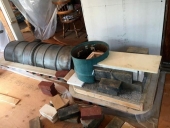





 1
1




For all your Montana Masonry Heater parts (also known as) Rocket Mass heater parts.
Visit me at
dragontechrmh.com Once you go brick you will never go back!








 1
1




For all your Montana Masonry Heater parts (also known as) Rocket Mass heater parts.
Visit me at
dragontechrmh.com Once you go brick you will never go back!








 1
1




For all your Montana Masonry Heater parts (also known as) Rocket Mass heater parts.
Visit me at
dragontechrmh.com Once you go brick you will never go back!
 1
1








 1
1




For all your Montana Masonry Heater parts (also known as) Rocket Mass heater parts.
Visit me at
dragontechrmh.com Once you go brick you will never go back!








 1
1




For all your Montana Masonry Heater parts (also known as) Rocket Mass heater parts.
Visit me at
dragontechrmh.com Once you go brick you will never go back!




thomas rubino wrote:Hey Diego;
I love helping people to build their Rocket mass heaters. The more folks who have one, the more they will tell other people!
Soon, world wide everyone will have an RMH and our air will be cleaner and everyone will be warm!
]I'm very happy to read this! ....
Thank you very much Thomas.
Together we make it possible to improve.
The proportion to be maintained with these materials is 1/3 clay / (sand, ash, crushed brick). Is it necessary that it be a part of each or can it be more sand than ash and brick?




 1
1




For all your Montana Masonry Heater parts (also known as) Rocket Mass heater parts.
Visit me at
dragontechrmh.com Once you go brick you will never go back!
 1
1




 1
1












For all your Montana Masonry Heater parts (also known as) Rocket Mass heater parts.
Visit me at
dragontechrmh.com Once you go brick you will never go back!
 3
3




 3
3




 1
1








Glenn Herbert wrote:I think the layer of bottles, encased in cob, will work fine and give decent insulation from the ground. As long as the bottles are not directly exposed to the fire they will not melt or break.
 3
3





| I agree. Here's the link: http://stoves2.com |








